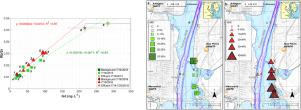Water Research ( IF 11.4 ) Pub Date : 2021-09-24 , DOI: 10.1016/j.watres.2021.117691 Joseph P Smith 1 , Thomas J Boyd 2 , Jennifer Cragan 3 , Matthew C Ward 3

|
Municipal wastewater (MWW) effluent discharges can introduce contaminants to receiving waters which may have adverse impacts on local ecosystems and human health. Conservative chemical constituents specific to the MWW effluent stream can be used to quantify and trace wastewater effluent-sourced contaminant inputs. Gadolinium (Gd), a rare earth element used as a contrasting agent in medical magnetic resonance imaging, can be found in urban MWW streams. Dissolved anthropogenic Gd has been shown to be an indicator and potential conservative tracer for MWW effluent in receiving waters. Like other known MWW tracers, it can be difficult and expensive to measure. Dissolved rubidium (Rb) to strontium (Sr) ratio enrichment in biological materials such as blood and urine can lead to enriched Rb/Sr values in MWW effluent relative to natural waters. This ratio is relatively easy and inexpensive to measure and represents a promising additional indicator for MWW effluent in receiving waters in urbanized freshwater systems. In July 2015 and 2016 surface water samples were collected from sites in the tidal-fresh Potomac River in the vicinity of the Blue Plains Advanced Wastewater Treatment Plant (BPAWWTP) outfall near Washington, DC USA along with treated MWW effluent samples from the BPAWWTP. Dissolved Rb/Sr ratios were measured in these waters and compared to dissolved Gd concentrations in order to demonstrate the potential of the dissolved Rb/Sr ratio as a conservative indicator for MWW effluent. Results suggest the dissolved Rb/Sr ratio represents a simple and cost-effective indicator and conservative tracer for MWW effluent. It can be used with, or in place of, other proven tracers to investigate wastewater impacts in highly-urbanized, anthropogenically-impacted freshwater systems like the tidal fresh Potomac River and perhaps in a wider range of geologic settings than previously thought. A case study is presented as an example to demonstrate the potential of using dissolved Rb/Sr ratios to trace MWW-sourced nutrient inputs from a major WWTP like BPAWWTP to the receiving waters of tidal-fresh Potomac River.
中文翻译:

溶解铷与锶的比例作为主要城市污水处理厂附近污水源污染物输入的保守示踪剂
市政废水 (MWW) 排放的污水可能会将污染物引入接收水域,这可能会对当地生态系统和人类健康产生不利影响。MWW 流出物特有的保守化学成分可用于量化和追踪源自废水流出物的污染物输入。钆 (Gd) 是一种在医学磁共振成像中用作造影剂的稀土元素,可以在城市 MWW 流中找到。已证明溶解的人为 Gd 是接收水域 MWW 流出物的指标和潜在的保守示踪剂。与其他已知的 MWW 示踪剂一样,测量起来既困难又昂贵。血液和尿液等生物材料中溶解铷 (Rb) 与锶 (Sr) 的比率富集可导致 MWW 流出物中相对于天然水的富集 Rb/Sr 值。该比率相对容易且成本低廉,并且代表了城市化淡水系统中接收水体中 MWW 流出物的一个有希望的附加指标。2015 年 7 月和 2016 年,从美国华盛顿特区附近 Blue Plains 高级污水处理厂 (BPAWWTP) 排放口附近潮汐新鲜的波托马克河中的地点收集了地表水样品,以及来自 BPAWWTP 的经过处理的 MWW 污水样品。在这些水中测量溶解的 Rb/Sr 比率并与溶解的 Gd 浓度进行比较,以证明溶解的 Rb/Sr 比率作为 MWW 流出物的保守指标的潜力。结果表明,溶解的 Rb/Sr 比代表了 MWW 流出物的一个简单且具有成本效益的指标和保守的示踪剂。它可以与,或代替,其他经过验证的示踪剂,用于调查高度城市化、人为影响的淡水系统(如潮汐淡水波托马克河)以及可能比以前想象的更广泛的地质环境中的废水影响。以案例研究为例,展示了使用溶解的 Rb/Sr 比率来追踪 MWW 来源的营养物质输入的潜力,这些营养物质从主要污水处理厂(如 BPAWWTP)到潮汐新鲜波托马克河的接收水体。











































 京公网安备 11010802027423号
京公网安备 11010802027423号